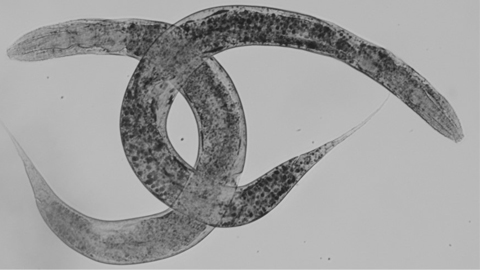
A study co-directed by Esther Dalfó, researcher at the INc, has identified a model of chromosome X-linked adrenoleukodystrophy (x-ALD) in the earthworm C. elegans. This is a rare disorder of the nervous system with no treatment available. The model will permit to accelerate and reduce the price of the research, which is studying the mechanisms and the possible pharmacological targets for the neuronal alterations of this disease.
Chromosome X-linked adrenoleukodystrophy (X ALD) is a rare genetic disease in which long-chain fatty acids accumulate in the blood and the nervous tissue, and where the myelin in the neurons is damaged. People who suffer from it (1 in 14,700 newborns) may have, among other things, brain and mobility problems, as well as hormonal disorders. The cause is a deficiency in the ABCD1 gene, which encodes the adrenoleukodystrophy protein (ALDP), which transports long-chain fatty acids to peroxisomes. These organelles play a very important role in lipid degradation and their subsequent cell use.
This work has identified and characterized the worm Caenorhabditis elegans (C. elegans) as a model of the disease, this model is deficient for the human analog protein (homologous) ALDP. The research team, co-led by Dr. Aurora Pujol, from the IDIBELL Neurometabolic Diseases group, and Esther Dalfó, leading the C elegans models of diseases group at the INC-UAB, analyzed the consequences of this deficit on a cellular level and found that, as in human and in existing mouse models, exists an accumulation of long-chain fatty acids, changes in lipid metabolism, oxidative imbalances in the mitochondria and neuronal disorders. The model will allow accelerating the study of this disease, for which there is currently no treatment.
The work, published in Free Radical Biology and Medicine, has involved ICREA researchers from the Bellvitge Biomedical Research Institute (IDIBELL), the Network Biomedical Research Center (CIBERER), the Neurosciences Institute of the Autonomous University of Barcelona (INc-UAB), the Faculty of Medicine of the University of Vic - Central University of Catalonia (UVic-UCC), the Kennedy Krieger Institute from Baltimore, the MRC Mitochondrial Biology Unit from Cambridge, and the Institute of Biomedicine from Seville (IBIS).
A valuable genetic tool
"This model of adrenoleukodystrophy in C. elegans is a very valuable genetic tool that will allow us to study the mechanisms involved in the disease and to find pharmacological targets faster than with other animal models, such as mice, which are much more complex and involve a costly and economically expensive process," says Esther Dalfó, who also is lecturer at the Faculty of Medicine of the UVic-UCC.
The research team has obtained its first results, which, despite being preliminary, suggest that glial cells, which are in the brain together with neurons, would be the first responsible for the neurological alterations associated with the disease.
"This new animal model has helped us to confirm that oxidative stress caused by mitochondria (the energy-producing organelles of cells) is the major cause of neuronal damage in adrenoleukodystrophy, and this mechanism of damage is conserved from the worm to the patient. The data point to new therapeutic pathways, such as mitochondrial antioxidants in peroxisome disease", says Aurora Pujol ICREA professor at IDIBELL.
C. elegans, neurons and genes like humans
The earthworm C. elegans is widely used in biomedical research because, despite being simple and small (measuring only 1 mm), it has most of the most complex animal structures and share most of the metabolic pathways with us. Besides, 40% of its genome is homologous to our genes and has a representation of all the neural populations in the human brain.
The genetic manipulation of this organism to create transgenic models to the study of the disease, such as X ALD, is faster than with other animal models such as rats or mice. Overall, taking into account characteristics like body transparency, numerous reproductions -up to 300 descendants- and the low cost, make the C. elegans an ideal tool for lab use.
Reference: Coppa A, Guha S, Fourcade S, Janani Parameswaran, Ruiz M, Moser AB, Schlüter A, Murphy MP, Lizcano JM, Miranda-Vizuete A, Dalfó E, Pujol A. The peroxisomal fatty acid transporter ABCD1/PMP-4 is required in the C. elegans hypodermis for axonal maintenance: A worm model for adrenoleukodystrophy. Free Radic Biol Med. 2020 Feb 1. pii: S0891-5849(19)32464-5. https://doi.org/10.1016/j.freeradbiomed.2020.01.177 [Epub ahead of print]






